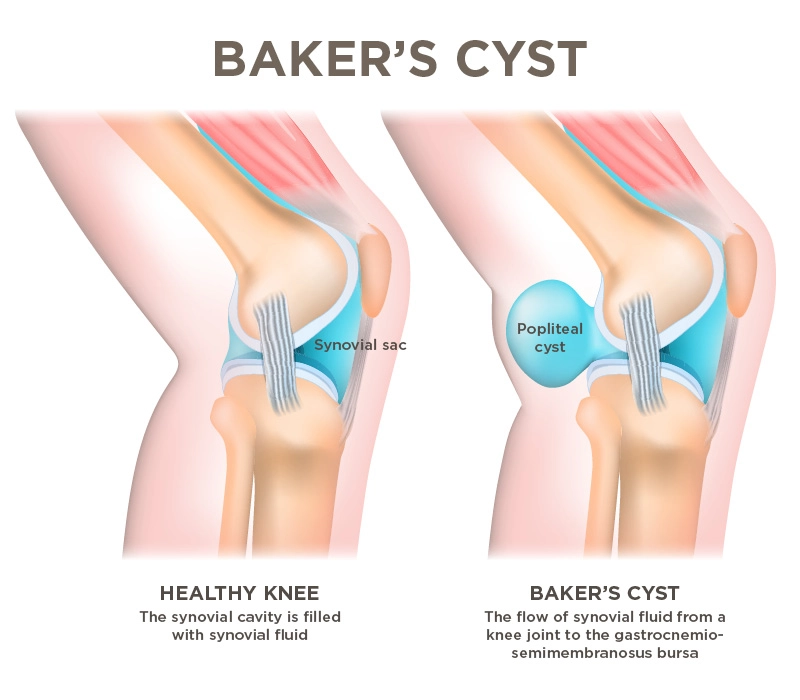A Baker’s popliteal cyst is a fluid-filled sac at the back of the knee. It is commonly linked to knee joint problems like arthritis or cartilage damage. While the cyst is not typically dangerous, it can cause feelings of badness and limit mobility if left untreated. This piece will discuss the signs, symptoms, and treatment options for a Baker’s cyst.
Causes of Baker’s Cyst
A Baker’s cyst is usually the result of excess fluid production in the knee joint, often due to underlying conditions such as:
- Arthritis: Hip and knee pain and rheumatoid arthritis are common culprits. These conditions cause inflammation in the knee, leading to fluid buildup.
- Meniscus Tears: Damage to the knee’s cartilage can trigger an overproduction of joint fluid, contributing to the development of a Baker’s cyst.
- Knee Injuries: Trauma or injuries, such as ligament strains or sprains, can increase joint fluid and cause a cyst to form.
- Inflammatory Conditions: Conditions like gout or lupus, which cause inflammation in the knee, can also result in cyst formation.
Symptoms of Baker’s Cyst
The symptoms of a Baker’s cyst can vary depending on the size and underlying cause, but common signs include:
- Swelling Behind the Knee: A noticeable lump or swelling at the back of the knee is the most common symptom.
- Pain or Discomfort: Mild to moderate pain, significant when fully extending or flexing the knee.
- Stiffness: The knee may feel rigid or tight, limiting your ability to bend or straighten the leg.
- Limited Mobility: In severe cases, the cyst can restrict movement or even cause locking of the knee joint.
- Calf Swelling: In rare cases, the cyst may burst, which causes fluid to leak into the calf, leading to swelling and discomfort.
Diagnosis
If you suspect a Baker’s cyst, a medical professional will usually perform a physical check and may suggest imaging tests such as an ultrasound or MRI to confirm the diagnosis. These tests help identify the size of the cyst and any underlying conditions that may be contributing to it.
Treatment Options for Baker’s Cyst
While a Baker’s cyst may sometimes resolve independently, treatment is often necessary if it causes significant discomfort or restricts mobility. Here are some standard treatment options:
- Rest and Ice: In mild cases, rest and ice packs can help reduce Getting bigger and alleviate discomfort.
- Compression and Elevation: Wearing a compression bandage and raising the leg can help manage symptoms and reduce swelling.
- Medications: Not steroids; anti-inflammatory drugs (NSAIDs) such as ibuprofen can help reduce pain and inflammation.
- Physical Therapy: Targeted exercises to strengthen the knee and improve flexibility can help manage symptoms and prevent future occurrences.
- Aspiration: In cases where the baker cyst causes significant discomfort, a doctor may drain the fluid using a needle, a procedure known as aspiration.
- Corticosteroid Injections: Corticosteroids can be injected into the knee to reduce inflammation and prevent fluid buildup.
- Surgery: If the cyst is large or doesn’t respond to conservative treatments, surgical removal may be necessary. In some cases, repairing the underlying cause (like a torn meniscus) can prevent the baker cyst from recurring.
Prevention Tips
To reduce the risk of developing a Baker’s cyst or prevent recurrence, consider these tips:
- Maintain a Healthy Weight: Reducing knee stress can lower the risk of joint issues.
- Strengthen Your Knee: Engage in exercises that strengthen the muscles around the knee to support joint stability.
- Protect Your Knees: Wear proper protective gear during activities that strain the knee, and avoid overuse or sudden impact injuries.
When to See a Doctor
If you experience persistent swelling, pain, or stiffness in your knee, it’s essential to consult a healthcare professional. Early findings and treatment can help manage symptoms and prevent complications.
Conclusion
Baker’s cysts are commonly linked to underlying knee problems and can cause discomfort if untreated. Being aware of the symptoms and seeking appropriate treatment can effectively manage a Baker’s cyst and prevent future issues. Always talk to a doctor to get a correct evaluation and personalized treatment plan.

